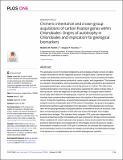Chimeric Inheritance and Crown-Group Acquisitions of Carbon Fixation Genes within Chlorobiales
Author(s)
Paoletti, Madeline M.; Fournier, Gregory P.
Downloadjournal.pone.0275539.pdf (5.517Mb)
Publisher with Creative Commons License
Publisher with Creative Commons License
Creative Commons Attribution
Terms of use
Metadata
Show full item recordAbstract
<jats:title>Abstract</jats:title><jats:p>The geological record of microbial metabolisms and ecologies primarily consists of stable isotope fractionations and the diagenetic products of biogenic lipids. Carotenoid lipid biomarkers are particularly useful proxies for reconstructing this record, providing information on microbial phototroph primary productivity, redox couples, and oxygenation. The biomarkers okenane, chlorobactane, and isorenieratene are generally considered to be evidence of anoxygenic phototrophs, and provide a record that extends to ∼1.64 Ga. The utility of the carotenoid biomarker record may be enhanced by examining the carbon isotopic ratios in these products, which are diagnostic for specific pathways of biological carbon fixation found today within different microbial groups. However, this joint inference assumes that microbes have conserved these pathways across the duration of the preserved biomarker record. Testing this hypothesis, we performed phylogenetic analyses of the enzymes constituting the reductive tricarboxylic acid (rTCA) cycle in Chlorobiales, the group of anoxygenic phototrophic bacteria usually implicated in the deposition of chlorobactane and isorenieretane. We find phylogenetically incongruent patterns of inheritance across all enzymes, indicative of horizontal gene transfers to both stem and crown Chlorobiales from multiple potential donor lineages. This indicates that a complete rTCA cycle was independently acquired at least twice within Chlorobiales and was not present in the last common ancestor. When combined with recent molecular clock analyses, these results predict that the Mesoproterzoic lipid biomarker record diagnostic for Chlorobiales should not preserve isotopic fractionations indicative of a full rTCA cycle. Furthermore, we conclude that coupling isotopic and biomarker records is insufficient for reliably reconstructing microbial paleoecologies in the absence of a complementary and consistent phylogenomic narrative.</jats:p>
Date issued
2022-02-10Department
Massachusetts Institute of Technology. Department of Earth, Atmospheric, and Planetary SciencesPublisher
Cold Spring Harbor Laboratory
Citation
Paoletti, Madeline M. and Fournier, Gregory P. 2022. "Chimeric Inheritance and Crown-Group Acquisitions of Carbon Fixation Genes within Chlorobiales."
Version: Final published version